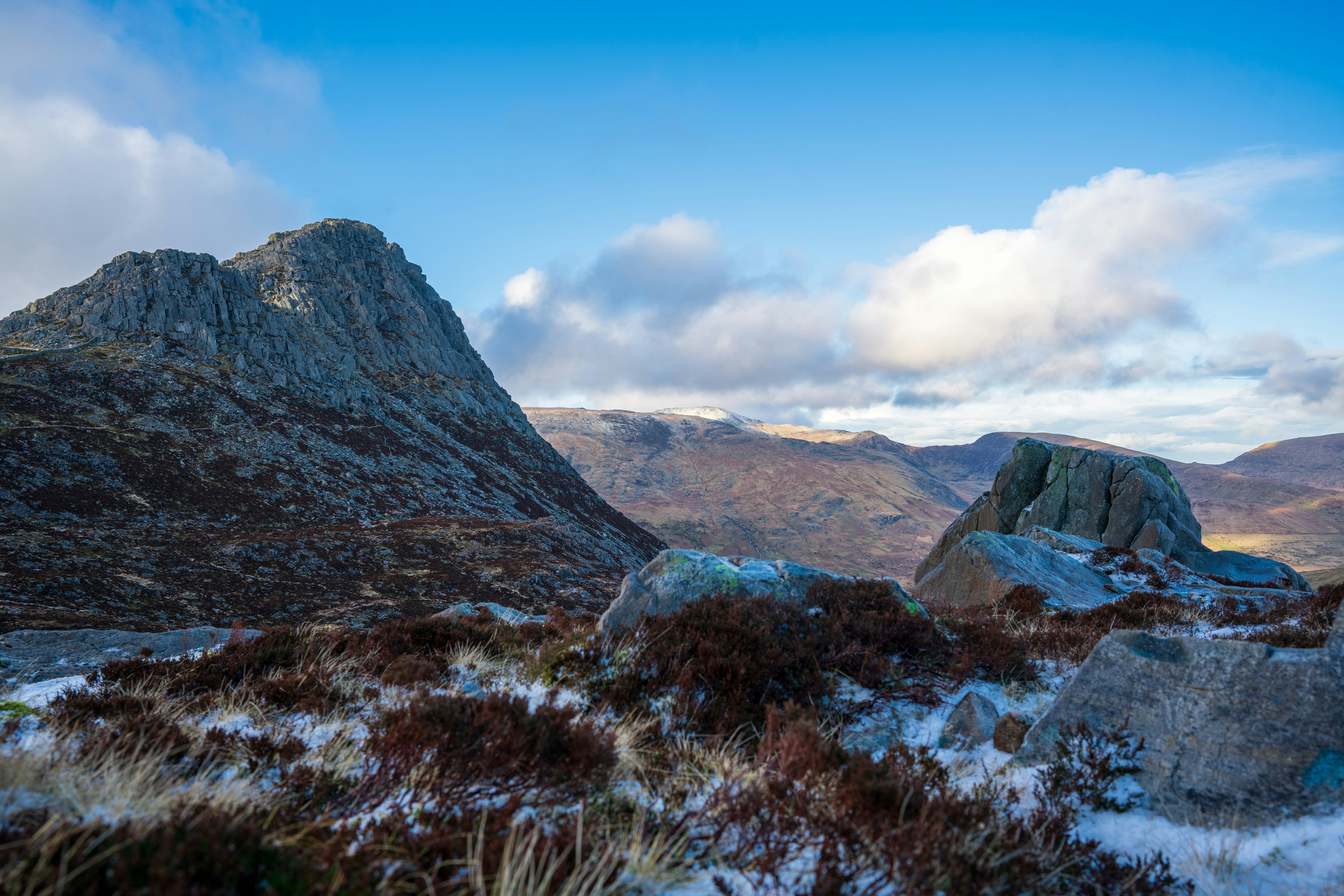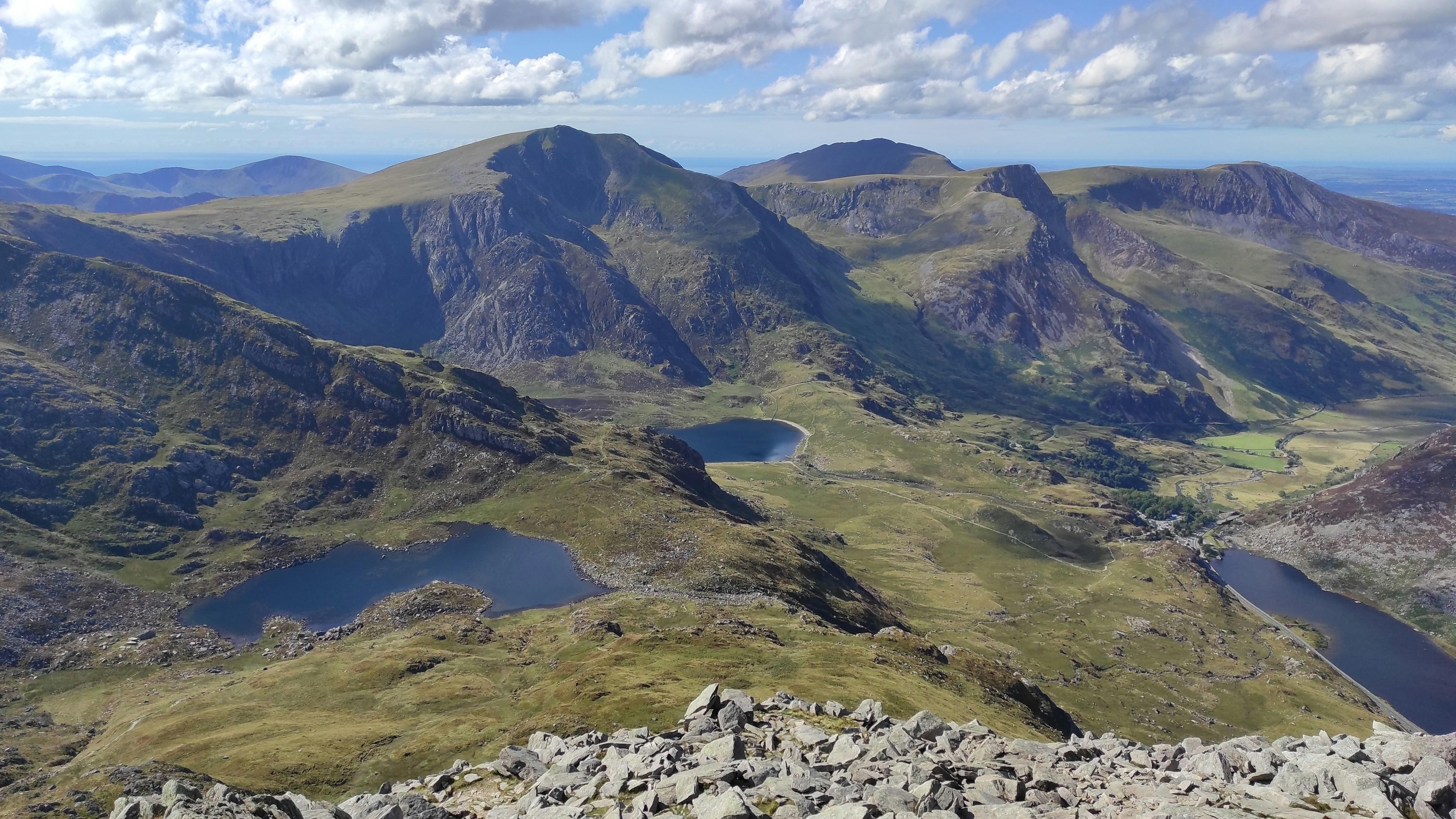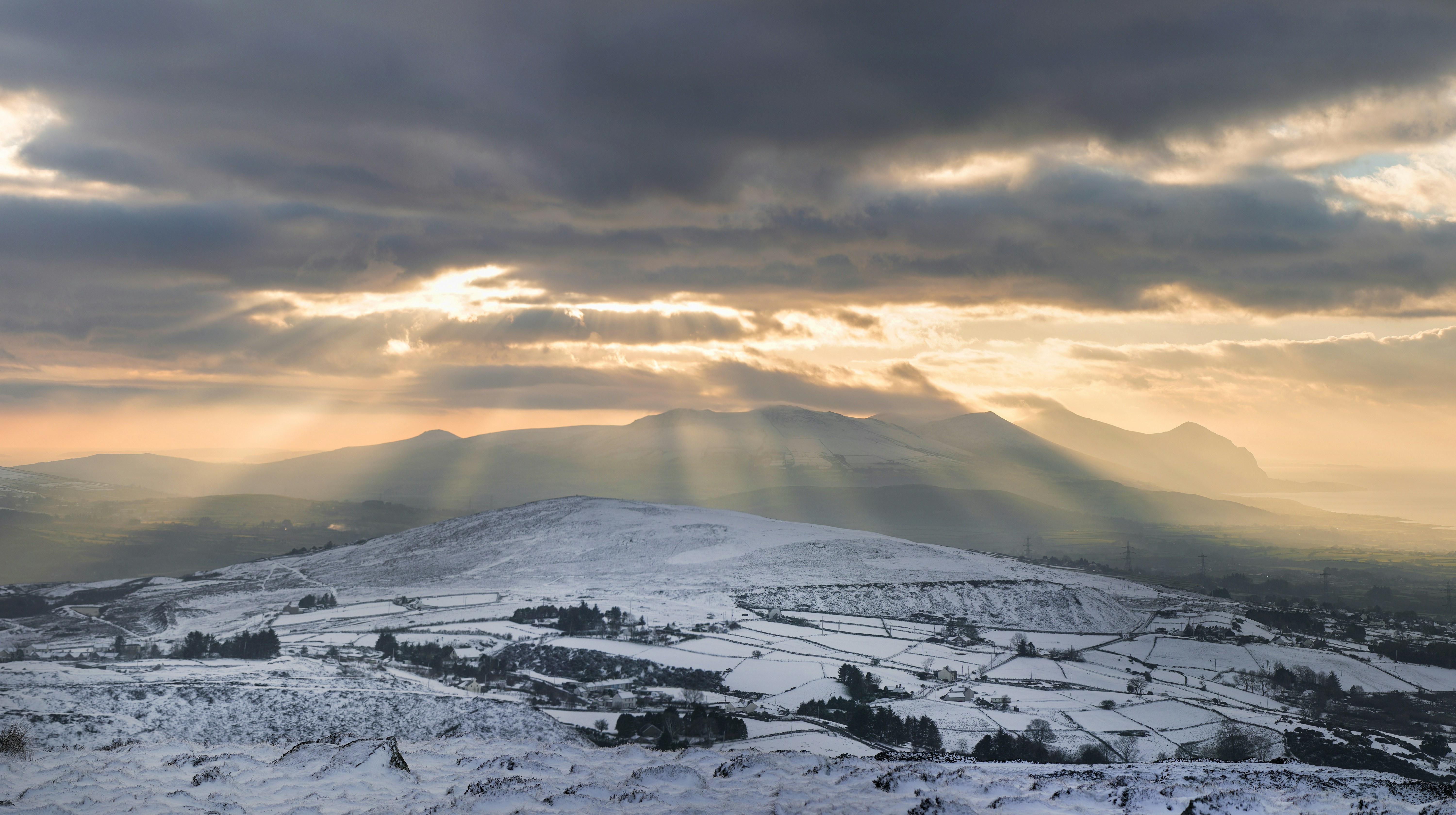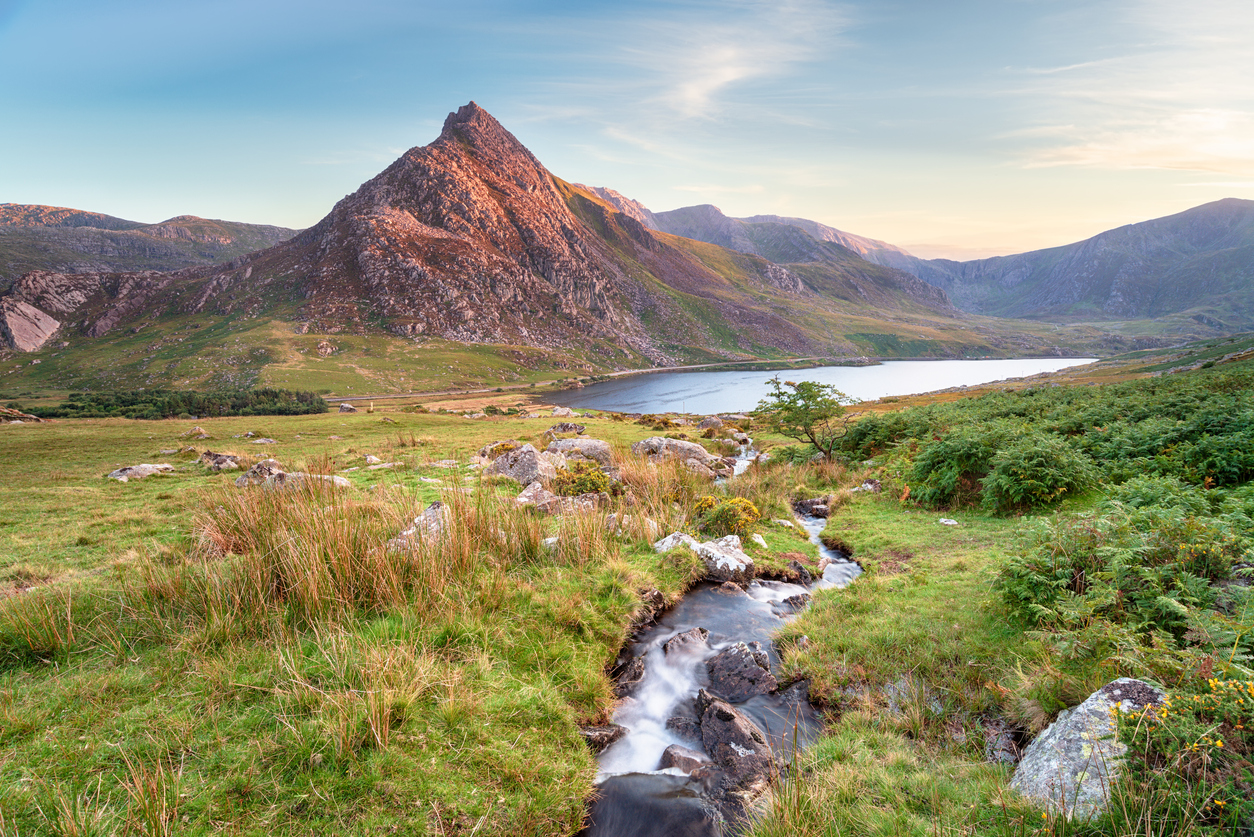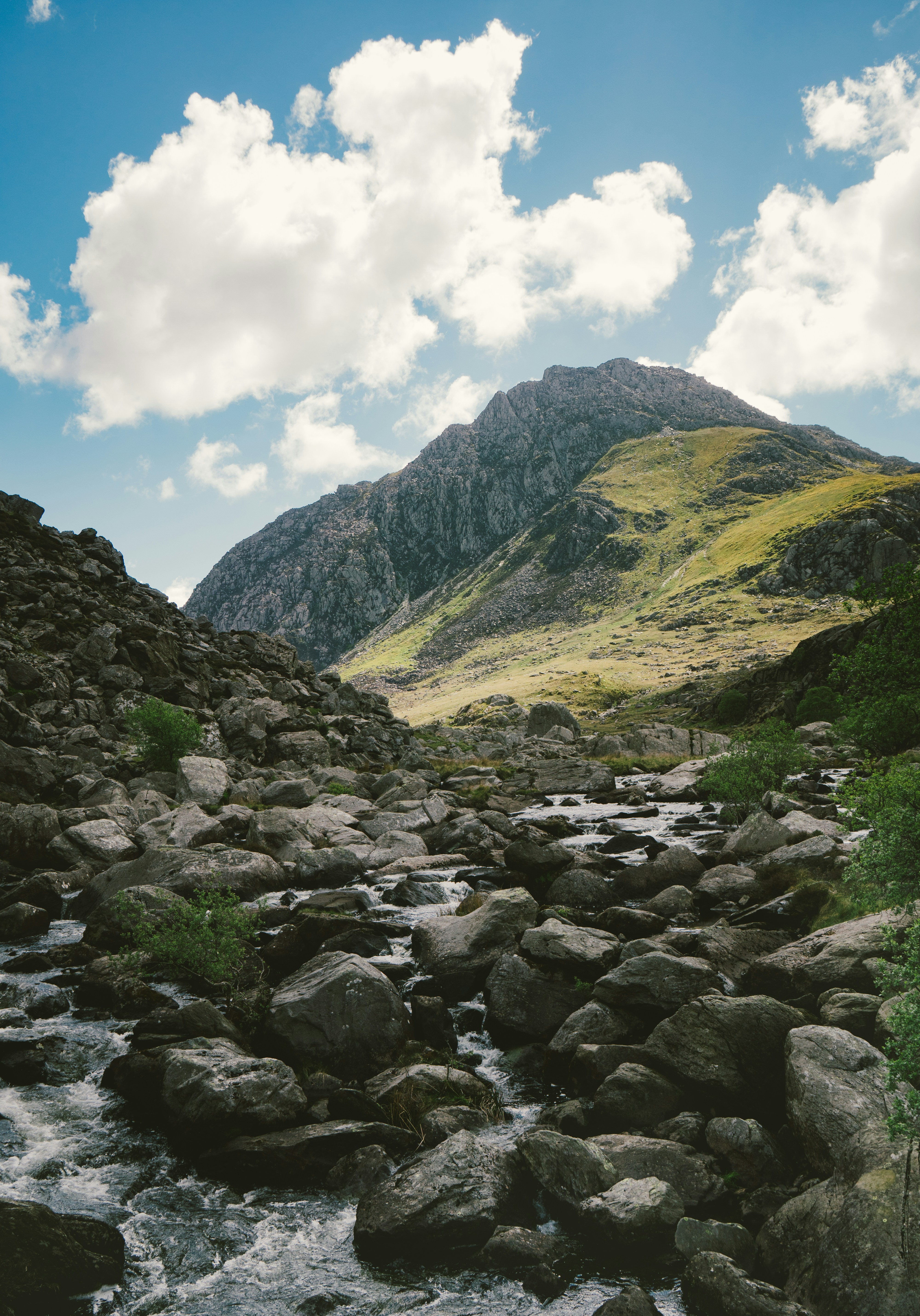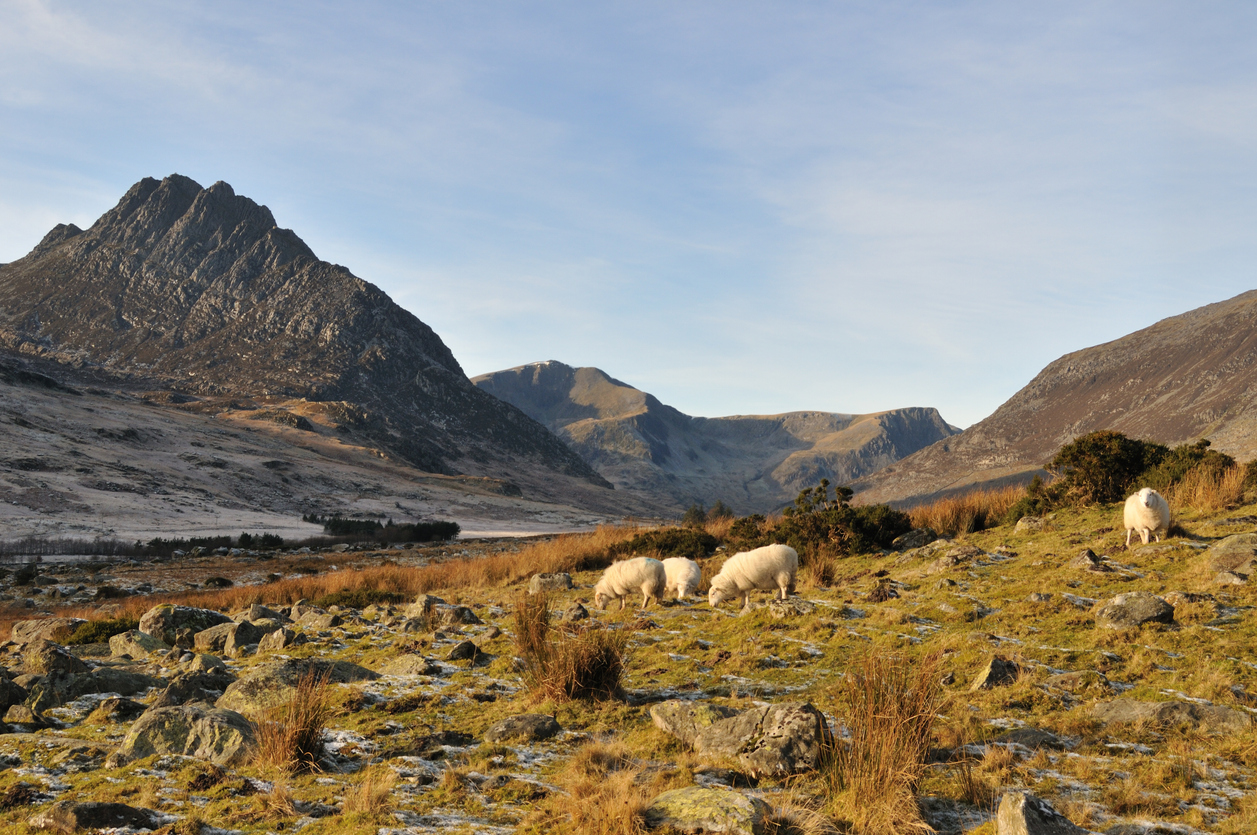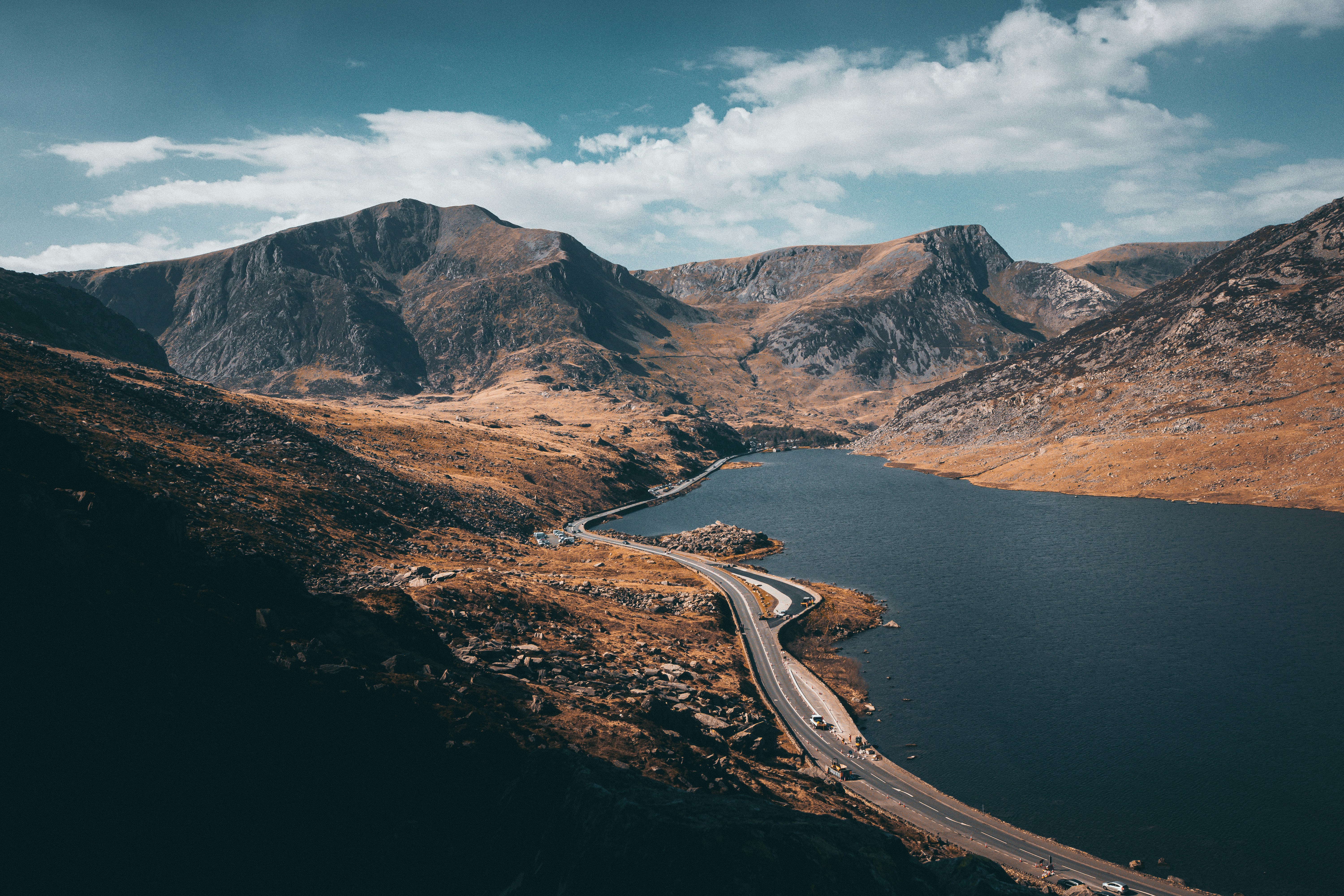Tryfan is one of the most recognisable and popular mountains in Snowdonia, North Wales. Towering at 917 metres (3,010 ft) above sea level, this impressive mountain offers incredible hiking opportunities with stunning views. The name Tryfan is derived from the Welsh word "trifan" meaning three peaks, referring to the three main rock towers or summits on the mountain. The upper part of Tryfan is made up of sedimentary rocks from the Ordovician period. Over years of exposure, weathering has resulted in many rock towers, pillars, boulders and loose rock on the summit area. This provides interesting scrambling and climbing challenges for adventurers. The lower slopes are smoother with softer outlines as they have a grassy covering.
Tryfan’s isolation from other peaks gives it a very distinct and recognisable shape when viewed from miles away. Approaching from any direction, it dominates the skyline. Tryfan also has significance in Arthurian legend and local Welsh folklore, featuring in tales from the Mabinogion collection. This air of mystery only adds to its draw for explorers and historians alike. The North Ridge is regarded as one of the best scrambling routes in Britain. Reaching the summit via the North Ridge is a rite of passage for many climbers and provides stunningly dramatic views, especially from the cantilevered Adam and Eve stones near the top.
Tryfan's Three Distinct Summits
At 917 metres (3,010 ft), Tryfan towers over the surrounding terrain and provides unparalleled views over Snowdonia. Owing to its geology and erosion patterns, Tryfan has three distinct summits of contrasting character.
Tryfan Main Peak
At 917 metres (3,010 ft), Tryfan’s main summit is the highest and most celebrated point, delivering incredible views and scrambling challenges. Its upper section is made up of weathered Ordovician rock towers and loose boulders requiring sure-footed scrambling to navigate safely. Approaching from Bwlch Tryfan via the North Ridge is the most direct access and climbs steadily up ever-steeper rock steps. The initial slabby stones underfoot give way to looser, larger outcrops requiring some boulder-hopping finesse to climb safely. As the ridge narrows, sheer drops down Tryfan’s East Face provide intimidating exposure on either side before the final crawl up to iconic Adam and Eve is made. Finding a safe line threading between these leaning monoliths is tricky with overhangs to traverse and drops to consider at every resting point. The final few airy moves pulling up between Adam and Eve should not be underestimated but reward brave scramblers with views out over the sheer North Face. Take time to appreciate how far you have climbed before the scramble back down the ridgeline begins. Descending via the North Ridge demands as much care as the lung-busting ascent with loose terrain ready to catch out tired walkers.
Glyder Fawr Nest
The subsidiary summit of Glyder Fawr Nest reaches 900 metres (2,953 ft), lying southwest of the main peak. Separated by a col saddle, the nest has a more rounded grassy aspect providing pleasant walking after the ankle-rolling rocks elsewhere. Its domed shape belies a rockier upper section though with sudden steps to look out for on the final approaches. Most scramblers access Glyder Fawr Nest by traversing from the main peak, passing towering rock bastions and loose gullies before the grade 1 terrain eases. The elevated vantage point allows amazing vistas over to Snowdon, Glyder Fach and the Devil’s Kitchen. Look out too for the steam train on the Llanberis Pass for an appreciation of how high you have climbed. Glyder Fawr Nest makes a fine spot sheltered from the wind to soak up the views whilst refuelling before the knee-jarring descent begins. Some parties choose to extend their traverse further west along connecting ridges to Tryfan’s third summit of Y Garn beyond. However, loose rock footing and sustained exposure here should not be taken lightly.
Y Garn
Y Garn lies east of the main peak, separated by a deep col with its pointed 947 metre (3,107 ft) summit often obscured from view. Y Garn appears as a fell in its own right, linked to Tryfan by an undulating rocky ridge. Despite fine views down into Cwm Bochlwyd, Y Garn is often overlooked as an objective. However, the steep eastern face presents a true sense of height and drama when viewed up close. The jagged linking ridge itself requires scrambling skill with some airy traverses to negotiate. Loose surfaces mean slips could prove catastrophic along sections so steady footing is key when handholds lack reliability. The reward for reaching Y Garn’s top is the unique outlook high above Llyn Idwal’s vivid blue waters not matched elsewhere. Take in the striking symmetry of Tryfan’s North Face buttresses with climbing lines visible on its sheer slabs. From this eagle-eye perspective, the terrain takes on a whole new scale with ant-like walkers tentatively descending. Use good judgment before committing to highly exposed sections of the ridge.
With distinctive summit experiences, incredible views and scrambling challenges for all abilities, Tryfan delivers adventure and rewards in equal measure. Conquering one summit is an achievement but the chance to compare all three makes for a memorable day out.
Popular Hiking and Scrambling Routes on Tryfan
There are several popular walking and scrambling routes to ascend Tryfan with the options varying in length, difficulty and terrain. As one of Snowdonia’s most iconic and commanding peaks, Tryfan is understandably a magnet for hikers and climbers. Having an awareness of the abilities, experience level and confidence of your group will determine the most suitable route up and appropriate precautions to take.
North Ridge
The iconic North Ridge scramble is undoubtedly Snowdonia’s most celebrated ridge walk. Its thrilling exposure, technical challenges and legendary Adam and Eve stones draw enthusiasts from across Britain. The ridge itself snakes around from Bwlch Tryfan, passing the imposing Milestone Buttress before the rocky ascent proper. The initial slabby steps require deft footwork and use of hands to find purchase on the way up. The grade 1 terrain stays largely safe but the intimidating East Face looms closer at every halt. Approaching Adam and Eve requires weaving between precarious pillars and overhangs to find the crux line slotting between the two summits. Climbing directly up between these leaning towers tests nerves and technique in equal measure. The final moves involve some airy exposure and clumsy clambering to crest the ridge. Once the col is reached though, the sense of achievement atop this legendary ridge is immense. The panorama down the sheer North Face is simply breathtaking. Descending is as taxing as ascending thanks to the knee-juddering loose rock.
South Ridge
While lacking the fame of its Northern cousin, Tryfan’s South Ridge still packs a scrambling punch. The rock architecture is starkly beautiful against the verdant hillsides with blades and slabs rearing up from steep grass. The start lies below imposing Castell y Gwynt, a heart-in-mouth scramble itself, before joining the main ridge. The initial weaving path soon gives way to the slabby ridge proper, snaking a line up the shattered rocks with care. The exposure ratchets up passing precarious traverses and slim ledges with concentration required not to dislodge debris. Scramblers should avoid the temptation to climb directly up challenging rock walls and corners, instead picking lines rightward on more forgiving steps. The crux comes as a smooth precarious slab that demands side-on edging and faith in friction to crest before the going eases. The summit rewards brave scrambling but many continue along the undulating crest to Glyder Fawr Nest beyond. Returning requires precise foot placements, often facing out with hands clutched to hold for security. Descents are understandably taken slowly with knees juddering on the relentless jagged
Heather Terrace route
The Heather Terrace route gives hillwalkers seeking Tryfan’s summit without serious scrambling a more straightforward option from Nant Peris. This path traverses under the East Face climbing steadily before views open up to the sprawling Heather Terrace with Adam and Eve coming into sight. Caution is still required not to stray too close to sheer edges onto loose terrain requiring hands. The final climb to the col between Adam and Eve should only be attempted if conditions are dry and no scrambling skill is demanded. More cautious hikers continue beneath the towers, traversing west under Milestone Buttress to reach Bwlch Tryfan for a safe descent on clearer paths. For those venturing the last airy pull-up to Tryfan’s 917m cairn, ensure you still have reserves left for a controlled descent back to terra firma the same way you arrived. While avoiding Tryfan’s most technical sections, Heather Terrace still requires fitness, knee support and careful footing on often wet, slippery surfaces contours around the mountain’s rocky architecture. Wise walkers resist the temptation to push limits higher simply because an easier approach path belies the commitment needed to climb and descend exposed summits safely.
Traversing Tryfan's Challenging Ridgeline
Having scrambled up the notorious North Ridge and taken in the unbeatable views from Adam and Eve, many adventurers then aim to traverse the entire ridgeline to bag all three of Tryfan’s distinct summits. Care should be taken when planning this longer expedition as the terrain underfoot, fickle weather and sheer drops make linking the various sections more committing.
Approaches to Milestone Buttress
The intimidating Milestone Buttress guards access to Tryfan’s North Ridge, presenting scramblers with an immediate challenge to overcome. The direct assault up the buttress itself is only recommended for confident climbers equipped to tackle sheer rock with significant exposure. The safer option is to approach via the Milestone Gully which traverses underneath the sandstone cliffs. While avoiding the most extreme technical climbing, the Gully still requires scrambling skill and steady nerves thanks to loose rock and steep drops down to Llyn Ogwen. Most parties use ropes for security here before continuing unroped along the North Ridge proper. Time spent honing technique on the Gully helps prepare for trickier sections awaiting after.
The North Ridge Climb
Emerging from below Milestone Buttress, scramblers suddenly find themselves fully exposed on knife-edge ridges with sheer drops on either side. Finding a safe climbing line up the shattered rock steps demands care and precision. Bold adventurers tackling the ridge directly face intimidating slab climbing and dangling traverses to overcome. The rough rock terrain places a huge strain on knees and ankles making progress tiring. Scramblers should check on each other often for signs of fatigue or nerves at the exposure. Eventually, the iconic Adam and Eve stones come into sight, signalling the final tricky clamber to Tryfan’s highest point.
The Descent
Reversing the ascent carries the dangers of tired limbs and depleted mental reserves. Many avoid the North Ridge relying instead on eroded gullies down parallel ridges. Study options for descent when energy is full before commitments are made. The Heather Terrace path gives an escape option west from Adam and Eve to bypass technical sections.
Whatever the chosen descent, self-awareness of physical limits is vital. Tryfan’s ridges vary from airy scrambling to loose knee-juddering pain so sustained concentration is key to avoiding accidents, even on home stretches back to valley floors.
Linking Tryfan's Summits
The exhilaration of reaching the top is often tempered on Tryfan by the realisation of only being halfway! Descending via the North Ridge is an option for proud summiters but linking the ridges to visit the other peaks is highly rewarding. Do not underestimate the challenges still ahead though when continuing the traverse.
Heading southwest from the 917m summit, a sharp rocky crest needs safely negotiated towards Glyder Fawr Nest. Though only topping out at 900m, Glyder Fawr Nest requires another knee-jarring climb up precarious boulders and sudden rock steps. The initial col looks innocuously grassy but hides hazardous partially hidden gullies to trap the unwary. Once past this, the going improves, and most parties can amble unroped to the top. Clear paths avoid steep sections, and the summit rewards perseverance with mighty views towards Snowdon and Glyder Fach as well as Tryfan’s towers behind you.
The worthwhile extension West from Glyder Fawr Nest to the 947m summit of Y Garn should only be attempted by capable scramblers undaunted by sustained exposure. An undulating crest of shattered rock connects the two summits with some airy drops requiring safeguards against deadly slips. The positive reward for this committing high-level traverse comes from Y Garn’s staggering views down the sheer East Face and North Ridge with the added perspective over Llyn Idwal’s serene waters framed magnificently far below.
After returning from Y Garn, the scramble back down to Glyder Fawr Nest must be negotiated before the knee-jarring descent to Bwlch Tryfan can commence. Wary walkers may choose to retrace the route for a safer descent. However, continuing North from the col completes the circuit in a satisfying style. Passing Tryfan’s outlier monuments of Heather Stone and Far Adam offers interesting route-finding challenges among the boulders before the Milestone Gully is attained once more for the final knee-juddering descent of the day.
Understanding the Weather on Tryfan
As one of the higher peaks in Snowdonia, reaching to 917 metres (3,010 ft), Tryfan sees more extreme weather conditions than surrounding lower valleys. It lies in the path of frontal systems sweeping in from the Irish Sea, bearing the brunt of driving rain, dense clouds and storm-force winds. Its altitude also makes it prone to rapidly descending fog and plunging temperatures even during settled spells. This extreme localised climate demands diligent weather checking and flexible planning when attempting to summit Tryfan.
The most reliable mountain forecasts come from the Met Office’s dedicated Lake District and Wales regional reports. These should be checked daily in the week leading up to any hike for an informed view of expected conditions. However, higher-ground forecasts can still only offer general guidance on the likely challenges. RemoteAutomatic Weather Stations such as that on the summit of Carnedd Dafydd provide great insight into recent conditions and visibility at altitude in real-time. Comparing multiple forecast models helps build a picture of any uncertainty such as differences in temperature, wind speed and precipitation predictions. Observed conditions in nearby valleys at the outset are only indicative so should not lure walkers into false confidence. Be prepared to turn back if conditions worsen higher up as low clouds and rain can descend rapidly without reaching lower ground. Traffic cameras such as on the A5 near Llyn Ogwen give an excellent early warning of deteriorations barreling in off the Irish Sea hours before they reach mainland peaks.
During any mountain hike, regular observations help gauge stability and build experience for the future. Monitor patterns in weather fronts, cloud formations and visibility at different altitudes. Note wind speeds and temperature changes compared to the forecast. Study features like blown snow plumes on ridges which suggest intense wind chill. Explaining observations to companions helps reinforce understanding and decision-making through better situational awareness as a team. Over multiple trips in varying conditions, recorded observations create an invaluable benchmark to reference when planning future trips to Tryfan. This helps make objectives realistic based on the collective experience and observed phenomena. With a better appreciation of the highly localised effects Tryfan’s altitude has on weather systems, teams can prepare responsibly and make dynamic decisions to stay safe on the slopes whatever the seasonal extremes throw down.
Related articles

Let us know you agree to cookies
We use marketing, analytical and functional cookies as well as similar technologies to give you the best experience. Third parties, including social media platforms, often place tracking cookies on our site to show you personalised adverts outside of our website.
We store your cookie preferences for two years and you can edit your preferences via ‘manage cookies’ or through the cookie policy at the bottom of every page. For more information, please see our cookie policy.

